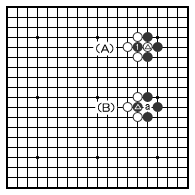Welcome to the Nihon Ki-in
HOW TO PLAY GO [ 2/3 ]
Forbidden Moves
In the game of'Go.'a player may place a stone at any intersection on the'Go'board. There are, however, exceptions to this rule. In Patterns A, B, and C in Diagram 6, the black player must not place his stones at (a) because (a) marks a 'dead spot.'In Pattern D, the black player, of course, may place his stone at (a) because it is not a'dead spot'surrounded by the stones of his adversary. In Pattern E, however, he can not place a black stone at (a).
Dia.6
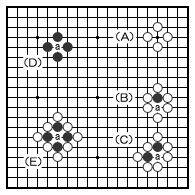

Exception
The rule of a'dead spot,'however, is not absolute. Under certain circumstances, a player may place his stone on a seemingly'dead'spot. In Pattern A in Diagram 7, (a) marks a spot where, according to the rule mentioned above, the black player cannot place a stone because it is surrounded by white stones. But in this case he may because by doing so he can kill the white stone marked .This means that the rule for placing a stone to kill an enemy stone overshadows the rule forbidding the placing of a stone in a 'dead spot.' Thus, after the black player placed a stone at (a) and removed a white stone, the pattern would be like B. Likewise, the placing of a single stone, which results in the removal of enemy stones, changes a pattern from C to D and from E to F.
.This means that the rule for placing a stone to kill an enemy stone overshadows the rule forbidding the placing of a stone in a 'dead spot.' Thus, after the black player placed a stone at (a) and removed a white stone, the pattern would be like B. Likewise, the placing of a single stone, which results in the removal of enemy stones, changes a pattern from C to D and from E to F.
 .This means that the rule for placing a stone to kill an enemy stone overshadows the rule forbidding the placing of a stone in a 'dead spot.' Thus, after the black player placed a stone at (a) and removed a white stone, the pattern would be like B. Likewise, the placing of a single stone, which results in the removal of enemy stones, changes a pattern from C to D and from E to F.
.This means that the rule for placing a stone to kill an enemy stone overshadows the rule forbidding the placing of a stone in a 'dead spot.' Thus, after the black player placed a stone at (a) and removed a white stone, the pattern would be like B. Likewise, the placing of a single stone, which results in the removal of enemy stones, changes a pattern from C to D and from E to F.Dia.7
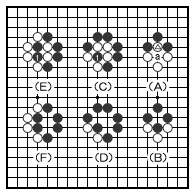

Stones That Never Die
The rules against certain moves are of crucial importance to the life and death of stones. In Pattern A of Diagram 8, the white player may place a stone at (a) as we mentioned earlier. What about placing one at (a) in Pattern B, then? The black stones are completely surrounded by white stones. But even if he places a stone at (a), the white player can not put the black stones in'atari.' Therefore, he cannot place a stone at either (a) or (b). A pattern of black stones like this, which has two open spots within it is said to have'eyes.' A pattern with'eyes'never dies. In Pattern B, the'eyes'are the spots marked (a) and (b). The expression'eyes'is derived from the importance of the two eyes for a human being to'live.'
Thus, making'eyes'is the minimum condition for survival in'Go.' A configuration with more than this minimum requirement never'dies.'Pattern C in Diagram 8 resembles B, but actually it is different in nature. The reason is that the white player, by placing a stone at (a), can remove the three black stones marked .
.
Thus, making'eyes'is the minimum condition for survival in'Go.' A configuration with more than this minimum requirement never'dies.'Pattern C in Diagram 8 resembles B, but actually it is different in nature. The reason is that the white player, by placing a stone at (a), can remove the three black stones marked
 .
.Dia.8
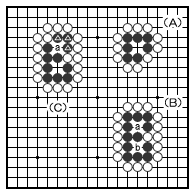

Surrounded Stones
When a stone or stones are removed after going through an'atari,'this means'instantaneous death.' On the other hand, there is another kind of'death'for stones those stones which, though kept on the board, are destined to die. Patterns A and B in Diagram 9 show such doomed stones. If a match ends with these stones in the same condition, they may be simply removed by the white player.In short, surrounded stones'die'so long as they cannot make'eyes.'
Dia.9
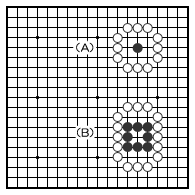

'Ko'-A special position.
There is only one more move that is barred. In Pattern A of Diagram 10, the black player can place a stone at (1) to capture a white stone marked .As a result, however, in Pattern B, the white player, too, can place a stone at (a) to remove the black stone marked
.As a result, however, in Pattern B, the white player, too, can place a stone at (a) to remove the black stone marked .
.
If this is done, the pattern reverts to A and the moves may be repeated ad infinitum. To avoid this, the rule is that when the configuration changes from A to B, the white player must not repeat the move. He can place his stone at (a) only after playcing a stone elsewhere. This kind of situation is called 'ko.'
 .As a result, however, in Pattern B, the white player, too, can place a stone at (a) to remove the black stone marked
.As a result, however, in Pattern B, the white player, too, can place a stone at (a) to remove the black stone marked .
.If this is done, the pattern reverts to A and the moves may be repeated ad infinitum. To avoid this, the rule is that when the configuration changes from A to B, the white player must not repeat the move. He can place his stone at (a) only after playcing a stone elsewhere. This kind of situation is called 'ko.'
Dia.10
